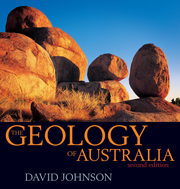Book contents
- Frontmatter
- Contents
- Map
- Preface
- Acknowledgements
- Map of main localities mentioned
- Abbreviations and units
- 1 An Australian perspective
- 2 The Earth: A geology primer
- 3 Building the core of Precambrian rocks
- 4 Warm times: Tropical corals and arid lands
- 5 Icehouse: Carboniferous and Permian glaciation
- 6 Mesozoic warming: The great inland plains and seas
- 7 Birth of modern Australia: Flowering plants, mammals and deserts
- 8 The history and evolution of life on Earth
- 9 Eastern highlands and volcanoes barely extinct
- 10 Building the continental shelf and coastlines
- 11 Great Barrier Reef
- 12 Planets, moons, meteorites and impact craters
- 13 A geological perspective on climate change
- 14 Cycles in a continental journey
- Sources and references
- Figure sources
- Index
6 - Mesozoic warming: The great inland plains and seas
Published online by Cambridge University Press: 05 August 2013
- Frontmatter
- Contents
- Map
- Preface
- Acknowledgements
- Map of main localities mentioned
- Abbreviations and units
- 1 An Australian perspective
- 2 The Earth: A geology primer
- 3 Building the core of Precambrian rocks
- 4 Warm times: Tropical corals and arid lands
- 5 Icehouse: Carboniferous and Permian glaciation
- 6 Mesozoic warming: The great inland plains and seas
- 7 Birth of modern Australia: Flowering plants, mammals and deserts
- 8 The history and evolution of life on Earth
- 9 Eastern highlands and volcanoes barely extinct
- 10 Building the continental shelf and coastlines
- 11 Great Barrier Reef
- 12 Planets, moons, meteorites and impact craters
- 13 A geological perspective on climate change
- 14 Cycles in a continental journey
- Sources and references
- Figure sources
- Index
Summary
Between 255 and 251 million years ago the world emerged from the icehouse. Why did the ice and snow disappear?
What can we say about the 140 million years during which the dinosaurs roamed Australia?
The final volcanic arc along eastern Australia extended from northern Queensland to the Otway region of Victoria. What terminated its eruptions?
WARM PLAINS AND THEN SEAS
The vast cold–climate peatlands that formed the Australian black coal deposits started to dry up, and a similar situation existed elsewhere in Gondwana. We can tackle this warming phase of Australian geological history in two parts.
The older and longer part lasted from 251 to 140 ma ago. Ice had begun to diminish about 255 ma ago and there was a great warming, at first forming an arid landscape dominated by inland rivers and lakes.
The second started 140 ma ago and lasted 40 million years. A rapid sea level rise formed great inland seas, with a volcanic arc down eastern Australia. The seas withdrew from 117 ma ago, leaving an essentially dry continent by 100 ma ago. Then began the break-up that led to the final disintegration of Gondwana.
A warming across the plains
Our interpretation of the climates is hampered because we are not sure of the sizes of the old mountain belts. As we know from today, mountains tend to capture atmospheric moisture, forming wetter environments for plants and animals and commonly creating drier areas on the leeward side.
- Type
- Chapter
- Information
- The Geology of Australia , pp. 123 - 144Publisher: Cambridge University PressPrint publication year: 2009



